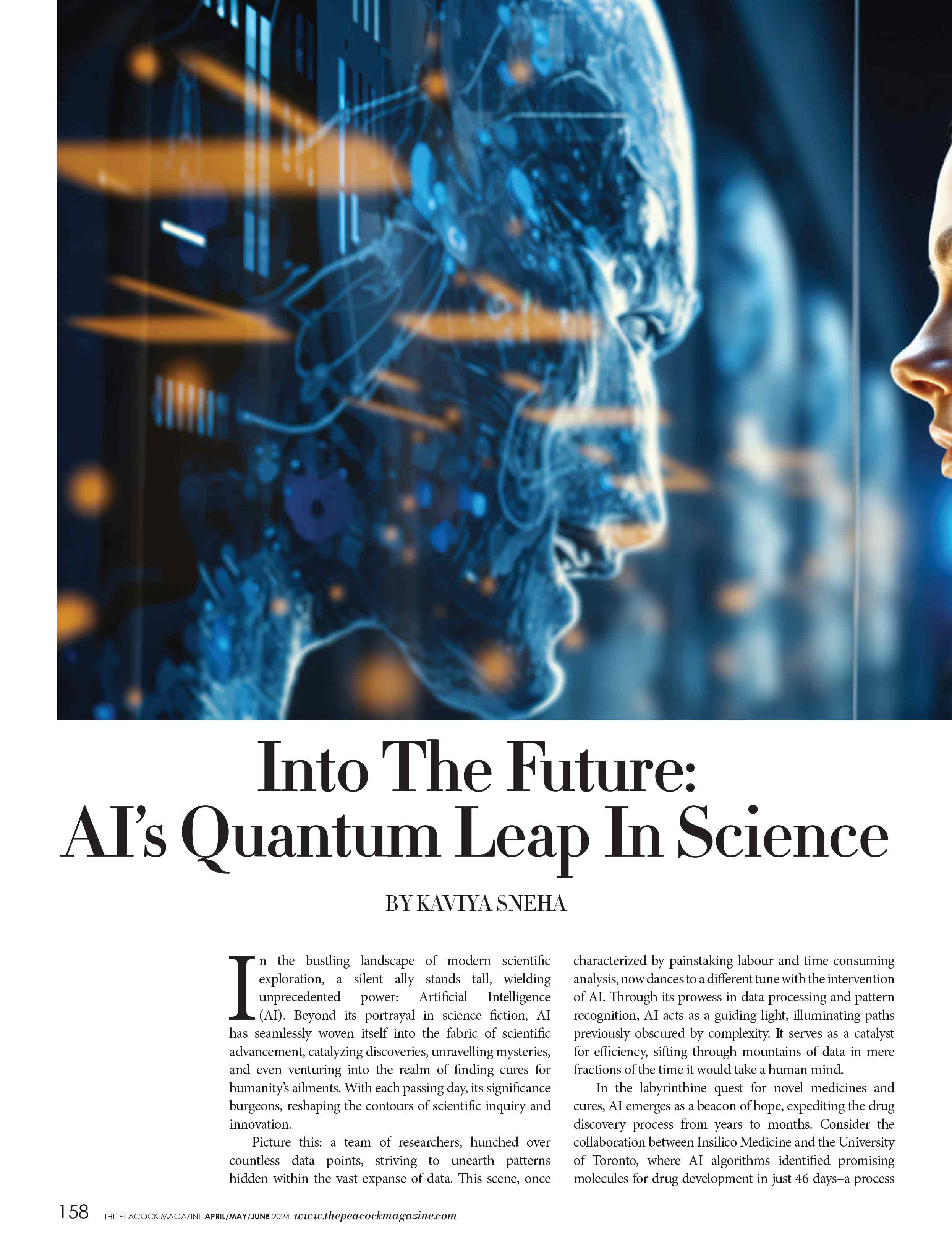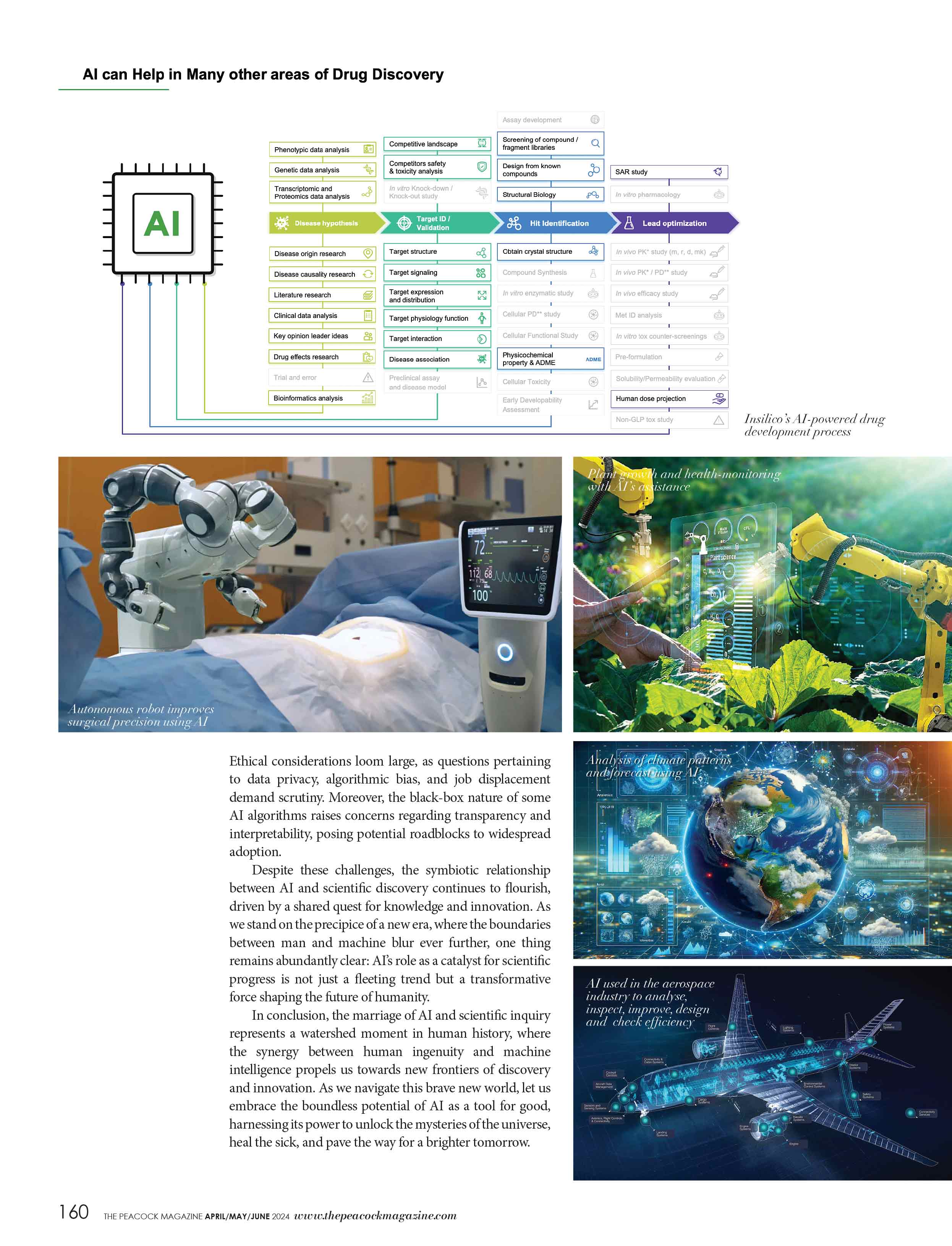
BY KAVIYA SNEHA
In the bustling landscape of modern scientific exploration, a silent ally stands tall, wielding unprecedented power: Artificial Intelligence (AI). Beyond its portrayal in science fiction, AI has seamlessly woven itself into the fabric of scientific advancement, catalyzing discoveries, unravelling mysteries, and even venturing into the realm of finding cures for humanity’s ailments. With each passing day, its significance burgeons, reshaping the contours of scientific inquiry and innovation.
Picture this: a team of researchers, hunched over countless data points, striving to unearth patterns hidden within the vast expanse of data. This scene, once characterized by painstaking labour and time-consuming analysis, now dances to a different tune with the intervention of AI. Through its prowess in data processing and pattern recognition, AI acts as a guiding light, illuminating paths previously obscured by complexity. It serves as a catalyst for efficiency, sifting through mountains of data in mere fractions of the time it would take a human mind.
In the labyrinthine quest for novel medicines and cures, AI emerges as a beacon of hope, expediting the drug discovery process from years to months. Consider the collaboration between Insilico Medicine and the University of Toronto, where AI algorithms identified promising molecules for drug development in just 46 days–a process that typically takes years using traditional methods.

Moreover, AI’s impact extends far beyond the confines of traditional scientific disciplines. In astronomy, AI algorithms sift through astronomical data, identifying celestial bodies and phenomena with unparalleled accuracy. The Kepler Space Telescope, with the assistance of AI, discovered an exoplanet (Kepler-90i) orbiting a distant star, marking the first time a multi-planet system was identified using machine learning techniques.
In genomics, AI unravels the intricate tapestry of DNA sequences, shedding light on genetic predispositions and disease mechanisms. Google’s DeepVariant is a prime example, significantly improving the accuracy of genomic sequencing, and enabling researchers to detect genetic mutations associated with diseases such as cancer more effectively.
Furthermore, in environmental science, AI models forecast climate patterns, aiding in the quest for sustainability and conservation. IBM’s Green Horizon initiative utilizes AI to predict air pollution levels in Beijing, empowering policymakers to take proactive measures to mitigate environmental degradation and safeguard public health.
In a recent Organisation for Economic Co-operation and Development (OECD) report exploring AI’s integration into scientific endeavours, the significance of this partnership is underscored. It emphasizes AI’s pivotal role in boosting research productivity, a cornerstone for economic growth and innovation. Urgent gaps in scientific knowledge, such as those in climate modelling and disease treatment, highlight the pressing need for accelerated research. AI’s impact reverberates through various domains, exemplified by Google DeepMind’s groundbreaking Alphafold 2, which revolutionised protein folding predictions. Furthermore, AI streamlines processes in microscopy and experimental design, while robotics, driven by AI algorithms, is reshaping laboratory operations.
In material engineering, AI designs novel materials with tailored properties, revolutionising industries ranging from aerospace to health-care. The collaboration between MIT and AI startup Citrine Informatics is exemplary, where machine learning algorithms accelerated the discovery of new material for use in solar panels by analyzing vast databases of material properties and chemical compositions. However, AI’s journey from laboratory bench to real-world applications is not devoid of challenges. Ethical considerations loom large, as questions pertaining to data privacy, algorithmic bias, and job displacement demand scrutiny. Moreover, the black-box nature of some AI algorithms raises concerns regarding transparency and interpretability, posing potential roadblocks to widespread adoption.

Despite these challenges, the symbiotic relationship between AI and scientific discovery continues to flourish, driven by a shared quest for knowledge and innovation. As we stand on the precipice of a new era, where the boundaries between man and machine blur ever further, one thing remains abundantly clear: AI’s role as a catalyst for scientific progress is not just a fleeting trend but a transformative force shaping the future of humanity.
In conclusion, the marriage of AI and scientific inquiry represents a watershed moment in human history, where the synergy between human ingenuity and machine intelligence propels us towards new frontiers of discovery and innovation. As we navigate this brave new world, let us embrace the boundless potential of AI as a tool for good, harnessing its power to unlock the mysteries of the universe, heal the sick, and pave the way for a brighter tomorrow.
